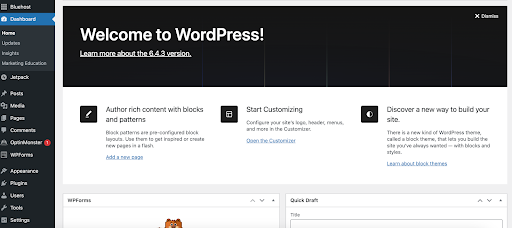WordPress is a widely used CMS known for its versatility and user-friendly nature. It is ideal for individuals at all skill levels seeking to create blogs, portfolios, or online stores without extensive coding knowledge. It caters to various website purposes such as blogging, e-commerce, business, and portfolio sites. WordPress lets non-techies launch websites using ready-made themes and drag-and-drop builders. Users who prefer a more personalized approach to website creation commonly opt for custom web development services. Whatever website creation method you choose, knowing the basics should help you achieve better results with your project. How does WordPress work? Let’s explore.
Table of Contents
ToggleWhat Is a WordPress Website?
A WordPress website is created using the WordPress platform, an open-source content management system (CMS) that enables you to build and manage your website or blog without requiring programming knowledge. WordPress is coded in PHP and utilizes MySQL for content storage. It is the most popular CMS globally, empowering over 43.1% of all websites.
With WordPress, you can craft various types of websites, such as business websites, eCommerce stores, blogs, portfolios, resumes, forums social network membership sites.
WordPress.org and WordPress.com
Beginners often find it confusing to differentiate between WordPress.com and WordPress.org. Let’s clarify their differences:
- WordPress.org serves as the central hub for the WordPress software. It provides access to downloads, documentation, forums for questions and discussions, and more.
- On the other hand, WordPress.com offers website services running on the WordPress platform. Users can easily sign up for a free account and have a fully functioning website with a WordPress subdomain.
The free version of WordPress.com includes all the essential features for running a website. However, if you want advanced customization options with your domain name or other features, you can opt for the premium version or get your hosting plan.
WordPress is managed by its core development team, along with support from an international community of independent open-source designers and programmers.
The core development team ensures software updates, including feature enhancements and security measures against potential vulnerabilities. Additionally, the open-source community provides instant knowledge-sharing support for improvements and bug fixes.
How Does WordPress Work?

WordPress operates using two essential components: PHP and MySQL:
- PHP, the server-side language on which WordPress is built, provides dynamism to the platform. It processes on the web server before delivering a page to the browser and is widely utilized due to WordPress’s popularity.
- In terms of database management, MySQL serves as an open-source relational database system that efficiently handles data organization akin to a complex spreadsheet with various categories. Users can access this database within WordPress to create, update, delete, and read diverse data types.
MySQL’s rapid response time in handling queries has propelled it to become the world’s second-most-used database management system. Kindly review these outlined points to understand better how WordPress functions with these components.
High-Level Overview of How WordPress Works
WordPress operates on three primary levels:
- It offers a user-friendly interface for website owners to manage their content database effectively.
- WordPress generates MySQL queries for the database, retrieves the necessary information, and publishes the page with the required data when a browser requests it.
- WordPress delivers versatility through its themes, plugins, and shortcodes that allow users to customize their site according to specific needs.
Key highlights:
- All content is stored in the MySQL database.
- The appearance of this information on the web depends on the selected theme.
- There are numerous themes available for browsing within WordPress.
- The mighty and flexible CMS allows seamless theme customization without impacting site content integrity.
You can access WordPress at three distinct levels:
- The user-facing site: This is accessed when visitors navigate to a path managed by WordPress (e.g., blog posts, and pages).
- Admin area or Dashboard: Accessible upon logging into WordPress as an administrator.
- Server files: These contain actual code and theme elements such as CSS and plugin files.
WordPress Admin Dashboard

The WP admin dashboard, also known as the WP Admin or WP admin panel, serves as the nerve center of your WordPress website. It acts as a centralized platform for creating and managing content, installing plugins to enhance functionality, changing themes to modify appearance, and more.
For WordPress users, understanding the functionalities of the WP admin panel is essential. Knowing how to locate the admin area and effectively use its features is crucial for site management.
The admin dashboard comprises multiple screens that enable you to manage various aspects of your website, such as installing themes and plugins while configuring settings. These screens include:
- The Dashboard Home Screen
- Posts, Categories, and Tags
- Media Uploads
- Pages
- Comments
- Appearance
- Plugins
- Users
- Tools
- Settings
Upon logging into the WordPress admin dashboard, you will be directed to a default screen containing widgets like activity quick draft, which provides an overview of necessary details about your WordPress website.
However, you will likely often navigate other areas within the WordPress administrator’s dashboard. You can access these areas through menu options in the sidebar. Although WordPress includes several default options, various themes & plugins may add additional menu items, resulting in slight differences in displayed menus on individual sites.
How to Edit Content in WordPress

When it comes to creating content in WordPress, users have the option to choose between two editors: the Classic Editor and the Gutenberg Editor. Both editors serve a similar purpose but have notable differences.
The Classic Editor offers a simple text editor interface that resembles Microsoft Word. In contrast, the Gutenberg WordPress block editor has an intuitive, user-friendly interface with easily accessible, self-explanatory icons.
In terms of content creation, while the Classic Editor provides a blank canvas for writing posts and pages, the Gutenberg WordPress block editor offers a wider range of features for creating content and efficiently managing its visual aspects.
Another significant difference lies in ease of use. The Classic Editor requires basic HTML knowledge to utilize all its capabilities, whereas the newer Gutenberg Editor does not demand technical expertise. Instead, users can simply drag and drop blocks to create pages and posts.
While the Classic Editor has basic formatting features for site editing, it lacks design flexibility, making it less suitable for creating media-rich pages or complex layouts. On the other hand, the Gutenberg Editor includes features such as reusable blocks that enable users to create templates and design complex layouts more quickly.
Also Read: Highly Recommended WordPress Page Builder Plugins
WordPress Themes and Plugins
Themes and plugins are essential add-on files that allow you to customize your website to meet your specific needs and those of your users.
By installing these additional files, you can alter the design of your site and incorporate extra functionalities. The admin dashboard enables easy installation and management of themes, plugins, and various uploads stored in the wp-content folder.
WP Themes- How Does WordPress Work
Theme files play a crucial role in determining the appearance of your website and how content is presented to your audience. Typically, only one theme is required to manage the visual aspect using a stylesheet template. Advanced users may opt for a Child Theme, which allows modifications without altering the original theme.
With numerous free or premium options available, selecting a theme that aligns perfectly with style and purpose while matching brand identity is crucial. These themes can also be customized through the Appearance section on the admin dashboard; they’re stored in the wp-content/themes directory.
WP Plugins
Incorporating plugins provides additional functionalities such as SEO improvement, image compression, video optimization, and monetization features. When building websites, it’s beneficial to install core plugins like security backups or SEO assistance, ensuring full optimization and enhanced performance.
Conclusion on How Does WordPress Work
We hope we have answered the question, “How does WordPress work?” WordPress is a highly adaptable CMS that caters to a wide range of website needs, including blogs and e-commerce stores. Its user-friendly interface and extensive customization options make it accessible to users of all skill levels. It’s crucial to grasp its core components, such as PHP and MySQL, and the disparities between WordPress.org and WordPress.com for effective website management. With themes, plugins, and intuitive editors like Gutenberg at your disposal, creating and customizing sites becomes effortless. WordPress provides the tools and support to realize your website vision, whether you’re just starting or have advanced skills.
Interesting Reads:
Streamlining Operations: How Upgrading MySQL Boosts Efficiency
Four Methods to Delete All Comments From WordPress
Here’s How to Convert Your PSD Design into a Responsive WordPress Theme







